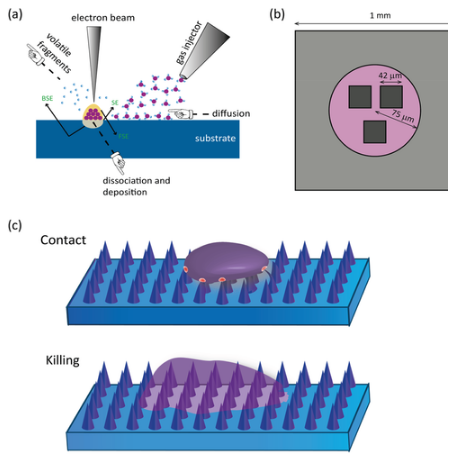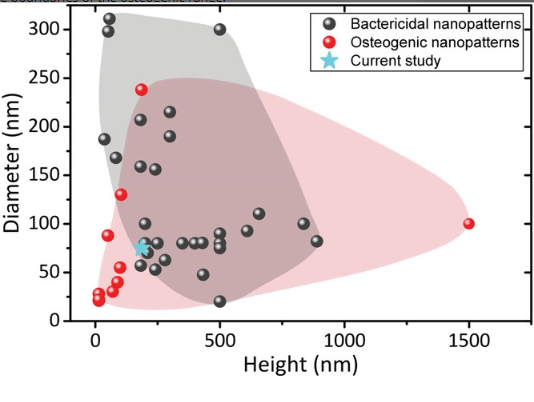In ‘Nature Helps: Toward Bioinspired Bactericidal Nanopatterns,’ Delft University of Technology researchers begin exploring the potential of synthetic bactericidal surfaces to help eliminate infection after surgical insertion of implants, many of which are 3D printed today. In this study, the researchers use electron beam induced deposition (EBID) to 3D print nanopillars that are both reproducible and ‘precisely controlled.’
While scientists around the world have made enormous progress in bioprinting, there are many challenges involved—beginning with cell sustainability and even getting to the point of creating an implant. But once placed into the body there are always concerns about infections too—even if the cells were patient-specific. Researchers have proposed numerous different ways for preventing bacteria and consequent infection, including creating surfaces able to ward off bacteria completely.
 The authors explain that so far, the different types of anti-bacterial surfaces being explored include noncytotoxic bactericidal surfaces or chemical methods delivering antibiotics or nanoparticles like silver or other agents. Along with this previous research, antibacterial surfaces have also proven successful. The key is, however, to have a surface that can not only kill bacteria but sustain cell viability too.
The authors explain that so far, the different types of anti-bacterial surfaces being explored include noncytotoxic bactericidal surfaces or chemical methods delivering antibiotics or nanoparticles like silver or other agents. Along with this previous research, antibacterial surfaces have also proven successful. The key is, however, to have a surface that can not only kill bacteria but sustain cell viability too.
Numerous natural features have led to further development of varying approaches for creating structures like nanopillars—some with dimensions of just a single nanometer. Natural surfaces such as dragonfly wings or cicada wings are not cytotoxic, but they do exhibit bactericidal properties.
“In the specific cases of Escherichia coli and Staphylococcus aureus as model organisms representing Gram‐negative and Gram‐positive bacteria, the reported ranges of dimensions of nanopillars to induce bactericidal behavior are as follows: diameters of 70–100 nm for S. aureus and 70–80 nm for E. coli, heights of 100–900 nm for S. aureus, and 180–300 nm for E. coli, and interspaces of 60–200 nm for S. aureus and 60–380 nm for E. coli.’
The authors also point out, however, that nanopatterns and corresponding bactericidal behavior often relate to different types and how attached they are to a surface. This study represents the first known experiments with EBID for creating nanopatterns with ‘high killing efficiency,’ for bacteria that is known to be both gram-negative and gram-positive. To be able to achieve surfaces that repel bacteria but allow cells to grow would be ‘the holy grail,’ but with EBID there is great potential due to the level of control available.

a) Schematic representation of the EBID method; b) sample design: dark gray indicates the patterned area, the pink area is close to the patterns, and the light gray area is far from the patterns; c) a schematic drawing demonstrating the fate of bacteria residing on nanopatterns including deformation on the nanopatterns upon contact and being sunk on the nanopatterns due to the penetration of nanopillars into the bacterial cell wall.
“The nanopatterned surface showed a high bactericidal efficiency against E. coli where almost all the bacterial cells were sunk on the nanopillars with the cell components leaked out and a distorted morphology,” stated the researchers. “However, the nanopatterns could not kill S. aureus as efficiently as E. coli. Considering that the bactericidal activity of the nanopatterns is physical in nature (corroborated by the results of Pt–C flat surface), the difference between the bactericidal efficiency against E. coli and S. aureus could be explained by the more rigid and thicker cell wall of S. aureus which requires higher forces to be ruptured.”

SEM images of E. coli bacteria on the control Si surface: a) top overview and b) 50° tilted view. SEM images of E. coli bacteria on the nanopatterned surface after 18 h incubation: c) top overview, d) damaged bacteria from top view, e) damaged bacteria from 50° tilted view, and f) bacteria totally sunk into the nanopatterns (50° tilted view).
The team suspects that other factors can also affect nanopatterned surfaces in relation to their bactericidal qualities, such as:
- Uniformity of patterns
- Compaction
- Density
- Wettability
During this study, the research team realized that EBID offers enormous potential but obstacles in upscaling patterned areas, taking 6.5 hours to produce each one. It is, however, necessary to create larger patterned areas.

Comparison of the dimensions (diameter and height) of nanopillars found in the literature displaying bactericidal and osteogenic activities. This graph illustrates that the nanopattern studied here is within the area where nanopatterns possess both bactericidal and osteogenic properties
“Regardless of the chosen upscaling technique, the underlying EBID technology is the key to achieving reproducible and precisely controlled nanopatterns and is therefore recommended for future studies,” concluded the researchers.
“Further investigations are required to determine the exact killing mechanism, the role of different factors involved in that process, and the possible osteogenic activity, since the dimensions of the current nanopatterns are within the osteogenic range. Although EBID is a very powerful technique to have control over all the dimensions of the nanopatterns in the fabrication process, the challenge of upscaling the patterned area while reducing the writing time is yet to be overcome. This is crucial for further experiments on mammalian cells, which are bigger in size than bacterial cells. Such an approach would open the way for the development of nanopatterns with simultaneous bactericidal and osteogenic potential that could be translated to clinical use in the future.”
Scientists have historically been inspired by nature for so many different inventions, and many today have led to innovation in 3D printing and more, from development of polymers to creating complex structures, and even toys. Antibacterial qualities to prevent infection offer serious benefits to patients around the world, however. Find out more about that here. What do you think of this news? Let us know your thoughts! Join the discussion of this and other 3D printing topics at 3DPrintBoard.com.
[Source / Images: Nature Helps: Toward Bioinspired Bactericidal Nanopatterns]
Subscribe to Our Email Newsletter
Stay up-to-date on all the latest news from the 3D printing industry and receive information and offers from third party vendors.
You May Also Like
Profiling a Construction 3D Printing Pioneer: US Army Corps of Engineers’ Megan Kreiger
The world of construction 3D printing is still so new that the true experts can probably be counted on two hands. Among them is Megan Kreiger, Portfolio Manager of Additive...
US Army Corps of Engineers Taps Lincoln Electric & Eaton for Largest 3D Printed US Civil Works Part
The Soo Locks sit on the US-Canadian border, enabling maritime travel between Lake Superior and Lake Huron, from which ships can reach the rest of the Great Lakes. Crafts carrying...
Construction 3D Printing CEO Reflects on Being Female in Construction
Natalie Wadley, CEO of ChangeMaker3D, could hear the words of her daughter sitting next to her resounding in her head. “Mum, MUM, you’ve won!” Wadley had just won the prestigious...
1Print to Commercialize 3D Printed Coastal Resilience Solutions
1Print, a company that specializes in deploying additive construction (AC) for infrastructure projects, has entered an agreement with the University of Miami (UM) to accelerate commercialization of the SEAHIVE shoreline...





























